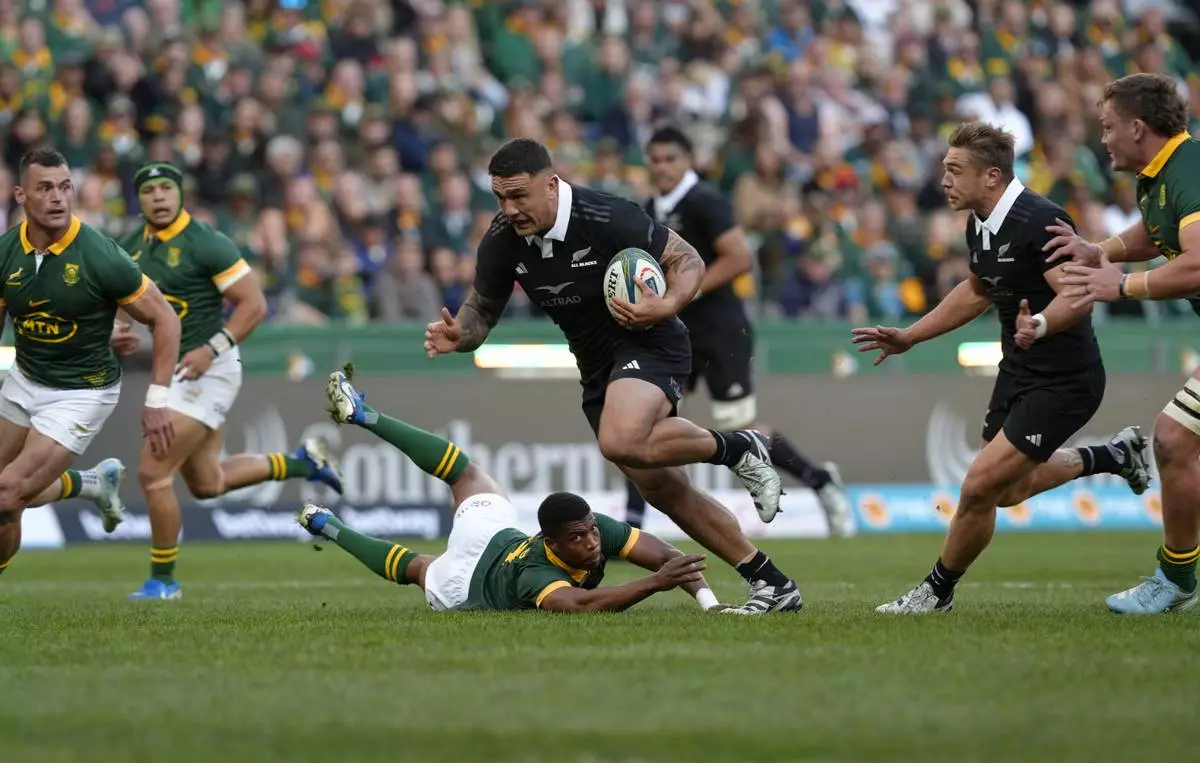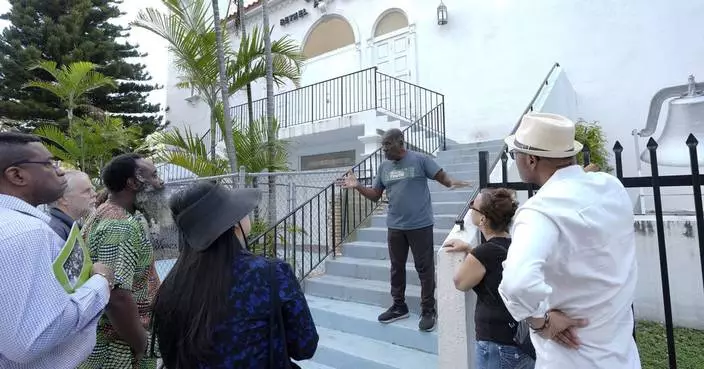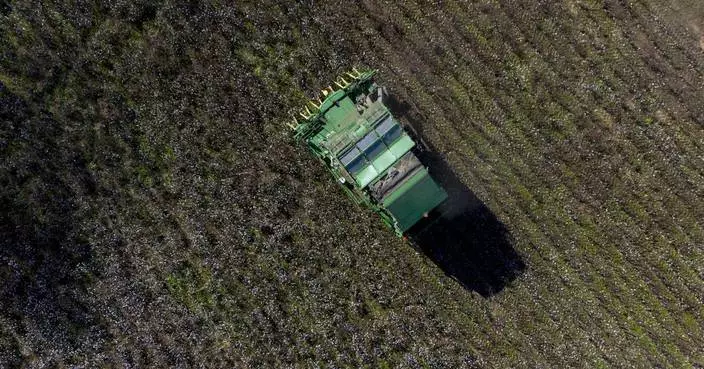WELLINGTON, New Zealand (AP) — Fullback Beauden Barrett will return to the starting 15 in the All Blacks team that will play Australia in the Rugby Championship and Bledisloe Cup test in Sydney on Saturday.
Barrett was named on the bench for the second test against South Africa in Cape Town two weeks ago as head coach Scott Robertson tried to add experience to solve New Zealand's problem with closing out matches.
Click to Gallery
New Zealand's Cortez Ratima, left, and South Africa's Grant Williams, center, go for possession of the ball during a rugby championship test match between South Africa and New Zealand at Cape Town Stadium, South Africa, Saturday, Sept. 7, 2024. (AP Photo/Nardus Engelbrecht))
Argentina's Los Pumas Juan Cruz Mallia, center, is tackled by Australia's Marika Koroibete, second right, during a rugby championship test match in Santa Fe, Argentina, Saturday, Sept. 7, 2024. (AP Photo/Mateo Occhi)
Australia's Ben Donaldson, center, is tackled by Argentina's Los Pumas Juan Martin Gonzalez during a rugby championship test match in Santa Fe, Argentina, Saturday, Sept. 7, 2024. (AP Photo/Mateo Occhi)
New Zealand's Codie Taylor, makes off with the ball during a rugby championship test match between South Africa and New Zealand at Cape Town Stadium South Africa, Saturday, Sept. 7, 2024. (AP Photo/Nardus Engelbrecht)
Argentina's Los Pumas Joaquin Oviedo runs with the ball to score a try against Australia during a rugby championship test match in Santa Fe, Argentina, Saturday, Sept. 7, 2024. (AP Photo/Mateo Occhi)
New Zealand's Scott Barrett, left, tackles South Africa's Ox Nche during a rugby championship test match between South Africa and New Zealand at Cape Town Stadium South Africa, Saturday, Sept. 7, 2024. (AP Photo/Nardus Engelbrecht)
The move was unsuccessful as the Springboks rallied to win the match 18-12 after also coming from behind to win the first test 31-27.
Barrett's return forces Will Jordan, who started at fullback in Cape Town, to return to the right wing.
In the other change to the All Blacks lineup, Ethan de Groot returns from injury at looshead prop, forcing Tamaiti Williams to the bench and Caleb Clarke is named on the left wing after overcoming a back injury.
Scrumhalf T.J. Perenara who also was named on the bench for the second Springboks test remains among the reserves as Cortez Ratima retains the starting role in his sixth test.
“We have selected an experienced team which has combinations that have played some of our best rugby this season," Robertson said. “The Bledisloe Cup is so revered by both of these teams, we are expecting a classic showdown against our Australian rivals.
"We have acknowledged the rich history of the Cup this week as a team and recognize that history does not bestow any rights. The Bledisloe Cup is always hard-earned and each year is its own chapter in the Bledisloe story.”
The All Blacks have held the Bledisloe Cup since 2003.
There will be heavy pressure on both teams in Saturday's test as they share 1-3 records in this season's Rugby Championship. The All Blacks had a win and a loss against Argentina in New Zealand then lost twice to the world champion Springboks in South Africa.
Australia lost two home tests against South Africa and won their first test in Argentina before losing last weekend's second test 67-27 after leading 20-3 in the 40th minute. It was the most points the Wallabies have ever conceded in a test match.
Meanwhile, Wallabies coach Joe Schmidt has resisted wholesale changes to the team so heavily beaten by Argentina. The New Zealand-born coach has recalled center Hunter Paisami and scrumhalf Nic White to his starting lineup, naming a new halves partnership as flyhalf Noah Lolesio also returns from injury.
Paisami and White both missed the Argentina tests and are named for the first time since the Springboks matches.
Backrower Fraser McReight will make his first Rugby Championship appearance of the season after recovering from a broken finger. Lukhan Salakaia-Loto returns from a shoulder injury to take his place on the bench and Tom Wright was named at fullback.
Prop James Slipper will come off the bench to break George Gregan's record for most test appearances for Australia in his 140th test.
“The players have reconnected well this week for our last game on home soil this year,” Schmidt said. ”We’ve acknowledged the poor finish to our time in Argentina and we’re keen to turn that around on what will be a particularly special day for James and his family.”
Australia: Tom Wright, Andrew Kellaway, Len Ikitau, Hunter Paisami, Marika Koroibete, Noah Lolesio, Nic White; Harry Wilson (captain), Fraser McReight, Rob Valetini, Jeremy Williams, Nick Frost, Taniela Tupou, Matt Faesller, Angus Bell. Reserves: Brandon Paenga-Amosa, James Slipper, Allan Ala'alatoa, Lukhan Salakaia-Loto, Langi Gleeson, Tate McDermott, Tom Lynagh, Dylan Pietsch.
New Zealand: Beauden Barrett, Will Jordan, Rieko Ioane, Jordie Barrett, Caleb Clarke, Damian McKenzie, Cortez Ratima; Ardie Savea, Sam Cane, Wallace Sititi, Tupou Vaa'i, Scott Barrett (captain), Tyrel Lomax, Codie Taylor, Ethan de Groot. Reserves: Asafo Aumua, Tamaiti Williams, Pasilio Tosi, Sam Darry, Luke Jacobson, T.J. Perenara, Anton Lienert-Brown, Sevu Reece.
AP rugby: https://apnews.com/hub/rugby

New Zealand's Cortez Ratima, left, and South Africa's Grant Williams, center, go for possession of the ball during a rugby championship test match between South Africa and New Zealand at Cape Town Stadium, South Africa, Saturday, Sept. 7, 2024. (AP Photo/Nardus Engelbrecht))

Argentina's Los Pumas Juan Cruz Mallia, center, is tackled by Australia's Marika Koroibete, second right, during a rugby championship test match in Santa Fe, Argentina, Saturday, Sept. 7, 2024. (AP Photo/Mateo Occhi)

Australia's Ben Donaldson, center, is tackled by Argentina's Los Pumas Juan Martin Gonzalez during a rugby championship test match in Santa Fe, Argentina, Saturday, Sept. 7, 2024. (AP Photo/Mateo Occhi)

New Zealand's Codie Taylor, makes off with the ball during a rugby championship test match between South Africa and New Zealand at Cape Town Stadium South Africa, Saturday, Sept. 7, 2024. (AP Photo/Nardus Engelbrecht)

Argentina's Los Pumas Joaquin Oviedo runs with the ball to score a try against Australia during a rugby championship test match in Santa Fe, Argentina, Saturday, Sept. 7, 2024. (AP Photo/Mateo Occhi)

New Zealand's Scott Barrett, left, tackles South Africa's Ox Nche during a rugby championship test match between South Africa and New Zealand at Cape Town Stadium South Africa, Saturday, Sept. 7, 2024. (AP Photo/Nardus Engelbrecht)
WASHINGTON (AP) — Facing a government shutdown deadline, the Senate rushed through final passage early Saturday of a bipartisan plan that would temporarily fund federal operations and disaster aid, dropping President-elect Donald Trump's demands for a debt limit increase into the new year.
House Speaker Mike Johnson had insisted Congress would “meet our obligations” and not allow federal operations to shutter ahead of the Christmas holiday season. But the day's outcome was uncertain after Trump doubled down on his insistence that a debt ceiling increase be included in any deal — if not, he said in an early morning post, let the closures “start now.”
The House approved Johnson's new bill overwhelmingly, 366-34. The Senate worked into the night to pass it, 85-11, just after the deadline. At midnight, the White House said it had ceased shutdown preparations.
“This is a good outcome for the country, ” Johnson said after the House vote, adding he had spoken with Trump and the president-elect “was certainly happy about this outcome, as well.”
President Joe Biden, who has played a less public role in the process throughout a turbulent week, was expected to sign the measure into law Saturday.
“There will be no government shutdown," Senate Majority Leader Chuck Schumer said.
The final product was the third attempt from Johnson, the beleaguered House speaker, to achieve one of the basic requirements of the federal government — keeping it open. And it raised stark questions about whether Johnson will be able to keep his job, in the face of angry GOP colleagues, and work alongside Trump and billionaire ally Elon Musk, who called the legislative plays from afar.
Trump's last-minute demand was almost an impossible ask, and Johnson had almost no choice but to work around his pressure for a debt ceiling increase. The speaker knew there wouldn’t be enough support within the GOP majority to pass any funding package, since many Republican deficit hawks prefer to slash federal government and certainly wouldn’t allow more debt.
Instead, the Republicans, who will have full control of the White House, House and Senate next year, with big plans for tax cuts and other priorities, are showing they must routinely rely on Democrats for the votes needed to keep up with the routine operations of governing.
“So is this a Republican bill or a Democrat bill?” scoffed Musk on social media ahead of the vote.
The drastically slimmed-down 118-page package would fund the government at current levels through March 14 and add $100 billion in disaster aid and $10 billion in agricultural assistance to farmers.
Gone is Trump’s demand to lift the debt ceiling, which GOP leaders told lawmakers would be debated as part of their tax and border packages in the new year. Republicans made a so-called handshake agreement to raise the debt limit at that time while also cutting $2.5 trillion in spending over 10 years.
It’s essentially the same deal that flopped the night before in a spectacular setback — opposed by most Democrats and some of the most conservative Republicans — minus Trump’s debt ceiling demand.
But it's far smaller than the original bipartisan accord Johnson struck with Democratic and Republican leaders — a 1,500-page bill that Trump and Musk rejected, forcing him to start over. It was stuffed with a long list of other bills — including much-derided pay raises for lawmakers — but also other measures with broad bipartisan support that now have a tougher path to becoming law.
House Democrats were cool to the latest effort after Johnson reneged on the hard-fought bipartisan compromise.
Rep. Rosa DeLauro, the top Democrat on the Appropriations Committee, said it looked like Musk, the wealthiest man in the world, was calling the shots for Trump and Republicans.
“Who is in charge?” she asked during the debate.
Still, the House Democrats put up more votes than Republicans for the bill's passage. Almost three dozen conservative House Republicans voted against it.
“The House Democrats have successfully stopped extreme MAGA Republicans from shutting down the government, crashing the economy and hurting working-class Americans all across the nation,” House Democratic Leader Hakeem Jeffries said, referring to Trump's “Make America Great Again” slogan.
In the Senate, almost all the opposition came from the Republicans — except independent Sen. Bernie Sanders, who said Musk's interference was “not democracy, that's oligarchy.”
Trump, who has not yet been sworn into office, is showing the power but also the limits of his sway with Congress, as he intervenes and orchestrates affairs from Mar-a-Lago alongside Musk, who is heading up the new Department of Government Efficiency.
The incoming Trump administration vows to slash the federal budget and fire thousands of employees and is counting on Republicans for a big tax package. And Trump's not fearful of shutdowns the way lawmakers are, having sparked the longest government shutdown in history in his first term at the White House.
“If there is going to be a shutdown of government, let it begin now,” Trump posted early in the morning on social media.
More important for the president-elect was his demand for pushing the thorny debt ceiling debate off the table before he returns to the White House. The federal debt limit expires Jan. 1, and Trump doesn't want the first months of his new administration saddled with tough negotiations in Congress to lift the nation's borrowing capacity. Now Johnson will be on the hook to deliver.
“Congress must get rid of, or extend out to, perhaps, 2029, the ridiculous Debt Ceiling,” Trump posted — increasing his demand for a new five-year debt limit increase. "Without this, we should never make a deal."
Government workers had already been told to prepare for a federal shutdown that would send millions of employees — and members of the military — into the holiday season without paychecks.
Biden has been in discussions with Jeffries and Schumer, but White House press secretary Karine Jean-Pierre said: “Republicans blew up this deal. They did, and they need to fix this.”
As the day dragged on, Senate Republican Leader Mitch McConnell stepped in to remind colleagues “how harmful it is to shut the government down, and how foolish it is to bet your own side won’t take the blame for it.”
At one point, Johnson asked House Republicans at a lunchtime meeting for a show of hands as they tried to choose the path forward.
It wasn’t just the shutdown, but the speaker’s job on the line. The speaker’s election is the first vote of the new Congress, which convenes Jan. 3, and some Trump allies have floated Musk for speaker.
Johnson said he spoke to Musk ahead of the vote Friday and they talked about the “extraordinary challenges of this job.”
Associated Press writers Kevin Freking, Stephen Groves, Mary Clare Jalonick, Darlene Superville and Bill Barrow contributed to this report.

Senate Majority Leader Chuck Schumer, D-N.Y., celebrates as the Senate begins voting on the government funding bill just in time to meet the midnight deadline, at the Capitol in Washington, Friday, Dec. 20, 2024. (AP Photo/J. Scott Applewhite)

Senate Majority Leader Chuck Schumer, D-N.Y., celebrates as the Senate begins voting on the government funding bill just in time to meet the midnight deadline, at the Capitol in Washington, Friday, Dec. 20, 2024. (AP Photo/J. Scott Applewhite)

Speaker of the House Mike Johnson, R-La., talks to reporters after passing the funding bill to avert the government shutdown at the Capitol in Washington, Friday, Dec. 20, 2024. (AP Photo/Jose Luis Magana)

Speaker of the House Mike Johnson, R-La., talks to reporters after passing the funding bill to avert the government shutdown at the Capitol in Washington, Friday, Dec. 20, 2024. (AP Photo/Jose Luis Magana)

The Capitol is pictured in Washington, Friday, Dec. 20, 2024. (AP Photo/J. Scott Applewhite)

Speaker of the House Mike Johnson, R-La., emerges from a closed-door meeting with fellow Republicans at the Capitol in Washington, Friday, Dec. 20, 2024. (AP Photo/J. Scott Applewhite)

Speaker of the House Mike Johnson, R-La., emerges from a closed-door meeting with fellow Republicans at the Capitol in Washington, Friday, Dec. 20, 2024. (AP Photo/J. Scott Applewhite)

Rep. Dusty Johnson, R-S.D., talks with reporters after attending a meeting with Speaker of the House Mike Johnson, R-La., as the House works on a spending bill to avert a shutdown of the Federal Government, Friday, Dec. 20, 2024, at the Capitol in Washington. (AP Photo/John McDonnell)

FILE - President-elect Donald Trump poses for a photo with Dana White, Kid Rock and Elon Musk at UFC 309 at Madison Square Garden, Nov. 16, 2024, in New York. (AP Photo/Evan Vucci, File)

Speaker of the House Mike Johnson, R-La., talks briefly to reporters just before a vote on an interim spending bill to prevent a government shutdown, at the Capitol in Washington, Thursday, Dec. 19, 2024. The vote failed to pass. (AP Photo/J. Scott Applewhite)

President-elect Donald Trump speaks during a news conference at Mar-a-Lago, Monday, Dec. 16, 2024, in Palm Beach, Fla. (AP Photo/Evan Vucci)































